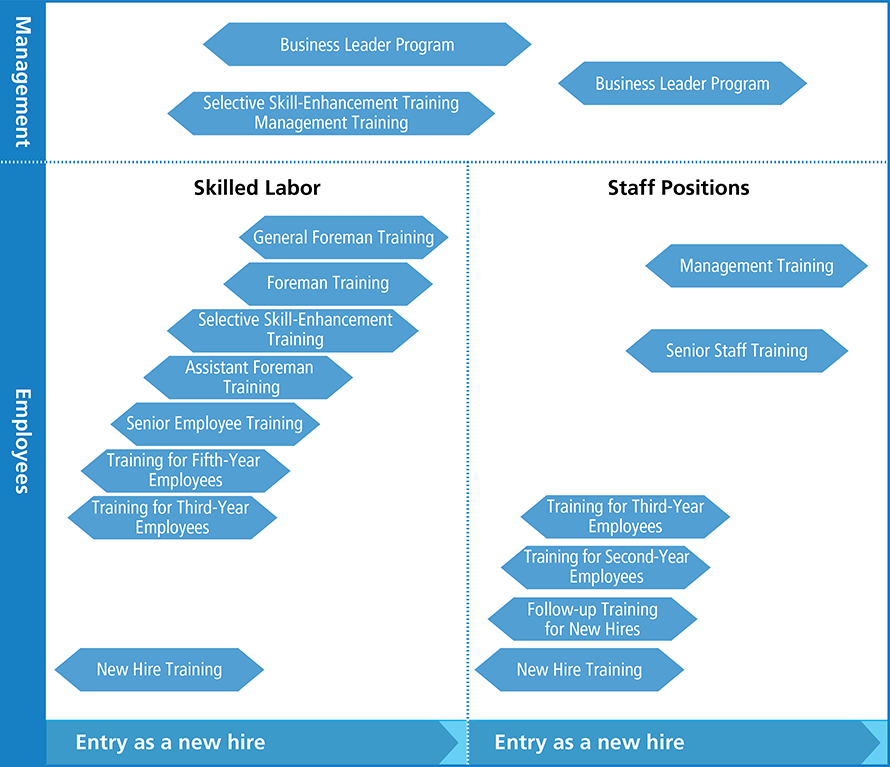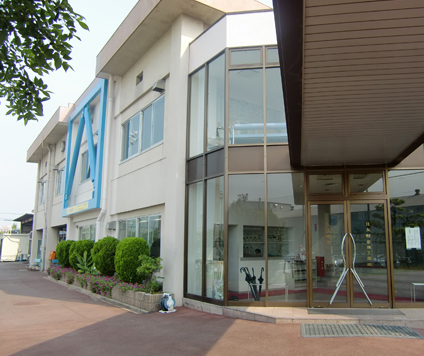Human Resource Development and Fair Treatment
Human Resources Development Initiatives
Basic Approach
We believe that cultivating individuals with the ability to make proactive decisions and take the lead in solving problems following the UACJ Way is essential for the Group’s future development in the evolving business environment. The objective of our human resource development initiatives is for each employee to grow individually and feel fulfillment in their careers.
Our initiatives follow the three fundamental concepts of “individual growth through learning,” “nurturing subordinates through work,” and “using our organization to cultivate people.” Based on these concepts, we provide position-based training, the Monozukuri Gakuen (manufacturing academy), the UACJ Knowledge Intensive Staff Innovation (U-KI), seminars, and self-development programs as well as our Next Generation Business Leaders and DX Human Resources training programs.
Human Resource Development Program
The UACJ Group offers various training programs, such as training and seminars for specific job positions using the facilities at the Human Resources Development Center at the Nagoya Works. We are also developing online programs to facilitate participation even from off-site locations. In fiscal 2023, a total of 1,530 members participated in 92 employee training sessions held over 192 days.
Per-Employee Training Data (Fiscal 2023)
- Avg. time spent in training: About 3.3 hours
- Avg. cost of training: About 16,000 yen
Job-Level Training
The purpose of job-level training is for employees to sharpen awareness of their job-level roles, acquire the professional capabilities and knowledge required to fulfill their job responsibilities, and deepen their understanding of the company’s aims and systems.
For staff employees, we conduct a series of training programs over the first three years of employment. For employees in their fourth year after joining the company and employees up through section manager level, we provide ongoing training geared to senior staff, management, new manager, organizational head and other job levels. We also conduct the Business Leader Development Program to prepare people for top management positions in the future.
For employees in skilled labor departments, we conduct training programs at the time of hiring and in the third and fifth years of employment. From the sixth year of service, employees participate in training as required for their job level.

Fiscal 2022 Job-Level Training Participation
(Individuals)
| UACJ | Affiliates | Total | |
|---|---|---|---|
| Management | 150 | 124 | 274 |
| Staff | 313 | 179 | 492 |
| Skilled Labor | 271 | 192 | 463 |
| Total | 734 | 495 | 1,229 |
Skill Improvement and Expert Knowledge Seminars
The UACJ Group, separate from job-level training, also conducts seminars mainly for the purposes of helping individuals improve their skills or acquire expert knowledge, and imparting knowledge required for particular workplaces.
Principal business locations held instructor-development training for mid-level employees, on-the-job training for new employees, and quality control, naze naze analysis*1 self-maintenance, PowerPoint, and other seminars. They also conducted seminars on the duties and responsibilities of company officers and on accounting and finance to help employees improve their business skills.
*1 Naze naze (why why) analysis is a problem-solving approach that focuses on ascertaining fundamental causes.
Support for Self-Development
We offer correspondence courses, support for acquiring official certifications, and language education to support the needs of individual employees and the work sites. In addition to our internal training and seminars, we also devote significant effort to external human resource development opportunities. In fiscal 2023, the company sponsored one individual to study at graduate school for self-development and human resource development.
Developing Human Resources for Overseas Roles
We maintain an overseas training system for a year of overseas language training followed by 18 months of overseas practical training. As of fiscal 2021, nine employees have used this system. The system helps develop human resources with skills to be active contributors to overseas activities from a long-term perspective.

Improving Frontline Capabilities (Handing down technical skills)
Efforts to pass on the monozukuri (manufacturing) spirit, experience, and skills veteran employees have developed and acquired over their long careers are critical for maintaining product quality and continuously improving productivity.
In preparation for the coming increase in veteran technicians reaching the mandatory retirement age, the UACJ Group’s Nagoya Works began a program in 2004 to transfer the skills, instinct, and “tricks of the trade” - the professional know-how – of veteran employees to their younger colleagues. In fiscal 2017, a similar initiative was launched at the Fukui Works, adding to others already underway in the maintenance department of the Nagoya Works, and the extrusion department of UACJ Extrusion Nagoya Corporation, where efforts are tailored to specific manufacturing circumstances.
We launched the Monozukuri Gakuen in 2019 to systematically manage the transfer of skills to younger generations. This program is presently underway in each of our businesses.
Meanwhile, we are actively rehiring retirees with technical backgrounds and making the most of their capabilities to enhance the skills of their younger colleagues.
Improving the Capabilities of Non-Manufacturing Staff
In fiscal 2020, the UACJ Group initiated UACJ Knowledge Intensive Staff Innovation (U-KI) activities primarily for our staff in non-manufacturing divisions with the aim of “building an energetic team that continues to achieve better results while developing our people and organization.”
The activities employ the Impact Method to cultivate a workplace culture like a baseball team that starts with honest communication and has everyone combining their knowledge and strengths. The U-KI method is also being used in position-based training and is actively used at Group companies in Japan and overseas.
The results of support efforts as of the end of fiscal 2023 are reflected in the numbers below.
- Business locations: 9
- Departments: 59
- Teams: 83
- Participants: 1,411
U-KI (UACJ Knowledge Intensive Staff Innovation) aims to create energetic teams that continuously and simultaneously produce better results and promote the growth of people and organizations. Starting with honest communication, U-KI is an approach for bringing together knowledge and capabilities to foster a team culture with significant contributions by all members. U-KI incorporates impact method approaches.
One-on-One Employee-Manager Dialogues
Once a year, we have every one of our employees engage in a personal dialogue with their manager to discuss topics such as their performance review and career development. Each employee rates their own performance and skills, and describes what they would like to do in the future. They also describe where they think they are in terms of performance and personal development, and their manager provides feedback. Each employee and their manager engage in a straightforward discussion of issues to address and objectives to meet, so the employee can achieve the desired growth and performance goals.
Employee Compensation
The UACJ Group properly compensates employees and makes no gender-based distinctions in base pay. Full-time employees are provided systems for life insurance, medical expenses, disability and illness guarantees, childcare leave, retirement allowance, and shareholding plan system. Non-regular employees (part-time, part-time workers, contract workers) are provided life insurance, medical expenses, childcare leave, and the shareholding plan system. Contract employees are eligible for the shareholding plan system only.
Practicing Talent Management
UACJ has set human resources, technology, and corporate culture as the key elements in creating the foundation for achieving our long-term management objective, UACJ VISION 2030. To fulfill our vision, we believe it is critically important to develop the human resources to lead the next generation and to strategically allocate personnel so each person will gain skills that can contribute anywhere in the Group without being restricted to divisions or locations.
With that perspective, we launched specific plans for human resource development and successor training in fiscal 2021. We extensively discussed the medium- to long-term growth strategies for each business and corporate division and the human resources that will be needed to implement the strategies. We also defined the specific human resources that will be needed for the management strategies and created plans to develop highly effective human resource development and successor training.
We also formulated and began a trial application of a talent management system to facilitate the strategic allocation of personnel. The system will improve our ability to strategically allocate staff to develop individuals for our future succession plan by providing centralized management of skill and experience development and facilitating global placement and human resource development. Defining human resources matched to the management strategies and launching the talent management system has improved our ability to visualize the human resource needs (talents) that are currently lacking or will be required in the future.
Even in a rapidly changing business environment, we will continue fostering a sense of group unity as we improve management efficiency and strengthen the integration of our management and human resource strategies to maximize synergies.
Employee-Management Relationship
Relations with labor unions are harmonious and information on the condition of the Company is regularly shared in central and business-site labor-management conferences. In April 2016, labor-management committees were formed at UACJ and at individual business sites to engage in ongoing discussions of measures for improving work-life balance by shortening working hours.
In addition, when deemed necessary, labor-management review committees are established to discuss issues and specific topics. We also initiate communicate with the labor union and the affected employees as early as possible regarding human resources management actions that have a significant impact on employees, such as transfers and changes in position.
Basic Workforce Data
UACJ Workforce Data
| FY2022 | FY2023 | |||
|---|---|---|---|---|
| Number of employees | 2,977 | (191) | 2,993 | (200) |
| Men | 2,700 | (172) | 2,694 | (180) |
| Percentage of men | 90.7% | 90.0% | ||
| Women | 277 | (19) | 299 | (20) |
| Percentage of women | 9.3% | 10.0% | ||
| Average age | 40.7 | 41.0 | ||
| Under 30 years old | 19.4% | 19.0% | ||
| 30 to 50 years old | 55.7% | 55.0% | ||
| Over 50 years old | 24.9% | 26.0% | ||
| Average length of service (years) | 16.3years | 16.3years | ||
| Number of new employees (excluding temporary transfers) | 197 | 190 | ||
| Men | 174 | 155 | ||
| Percentage of men | 88.3% | 81.6% | ||
| Women | 23 | 35 | ||
| Percentage of women | 11.7% | 18.4% | ||
| Number of employees that left the Company | 162 | 181 | ||
| Men | 152 | 164 | ||
| Percentage of men | 93.8% | 90.6% | ||
| Women | 10 | 17 | ||
| Percentage of women | 6.2% | 9.4% | ||
| Turnover rate | 5.4% | 6.0% | ||
| Of which, left for personal reasons | 3.1% | 3.7% | ||
- Note1 Figures in parentheses are the numbers of temporary employees (not included in totals)
- Note2 As of March 31 of each year
UACJ Group Workforce Data (consolidated)
| FY2022 | FY2023 | |||
|---|---|---|---|---|
Number of group employees |
9,510 | (719) | 10,460 | (807) |
| Men | 8,113 | (606) | 8,697 | (660) |
| Percentage of men | 85.3% | 83.1% | ||
| Women | 1,397 | (113) | 1,763 | (147) |
| Percentage of women | 14.7% | 16.9% | ||
| By region | ||||
| Japan | 5,707 | (533) | 6,106 | (678) |
| Asia | 2,014 | (17) | 2,360 | (59) |
| North/South America | 1,673 | (169) | 1,870 | (69) |
| Europe and other | 116 | (0) | 124 | (1) |
Note Figures in parentheses are the average numbers of temporary employees (not included in totals)

